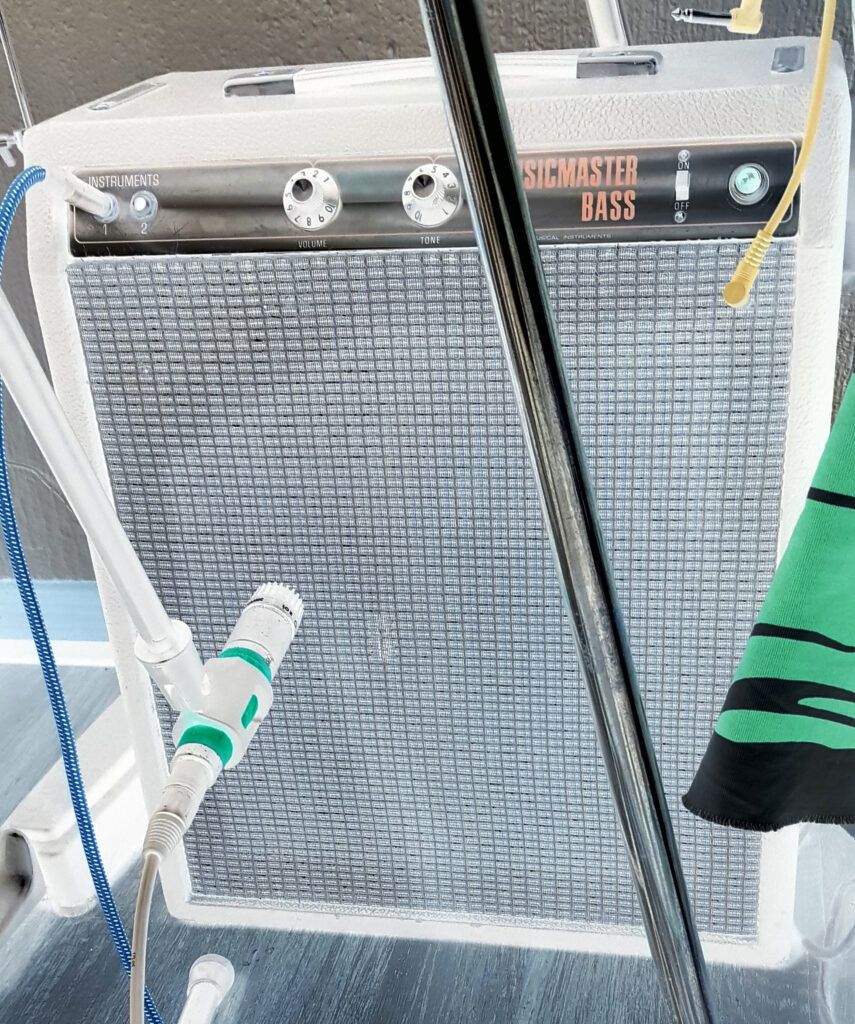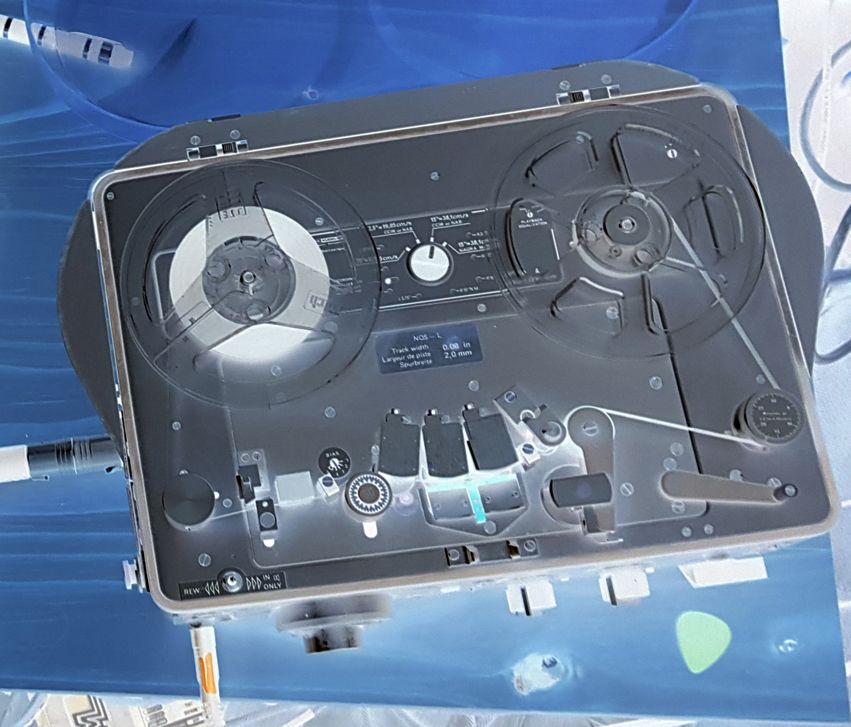An anxiety that has surrounded electronic music since its inception concerns what can be called its virtuality: that its play of sonic objects seems to occur on a plane removed from one of ‘real,’ ‘actual,’ ‘physical’ materials, bodies and events.
Once it became possible, in the mid-twentieth century, to showcase the fruits of the studio through loudspeaker alone, many composers and performers looked for ways to rediscover ‘liveness,’ ways to reintegrate the presence and agency of the human bodies in the room, whether through forms of indeterminacy or through new visual and kinetic spectacles, especially those bearing observable relationships to resulting sound.
It became possible, around the same time, to make musique concrète, togenerate sonic texts that bore little resemblance to hitherto existing relationships of material cause and acoustic effect. Egyptian composer Halim El-Dabh was one of the first to explore this possibility with his pieces for wire recorder and tape. And with it, musical aesthetics entered a strange new phase. Some, such as Pierre Schaeffer, encouraged audiences to listen to sonic form and object purely, rather than to sound sources, while others, like R. Murray Schafer feared the contextlessness and inauthenticity of the resulting ‘schizophonia.’

Since digital technologies have become the norm in production and listening, many musicians and listeners, especially in popular music, have regarded analogue technology as the path back to material reality – but the anxieties surrounding electronic music’s virtuality extend back well into the analogue era. Besides which, digital technologies are no less material than analogue ones. It is just that their materiality tends to lie at a greater remove from the bodily scale of the individual — be it the microcircuitry hidden among the chips screwed in beneath the plastic, or the enormous factories that make them far away across the globe — so that their virtual character is more obvious and extensive at the point of interaction.
But while virtual music might be a more mysterious music, and might even be dishonest (to the extent that that matters to a given audience, when all music is fiction of a sort), it is not necessarily an impoverished music. Shane Cooper’s Tape Collage, inspired by El-Dabh, draws on analogue sources and effects, both acoustic and electronic, and records and combines them using the modern Digital Audio Workstation. In the process, he tests and questions the semiotic borders that can be drawn between virtual environments of musical perception and their physical counterparts.

This is true from the opening notes of a closely recorded lamellophone. They appear to the listener only as sound objects presented through speakers or headphones and yet, pace Pierre Schaeffer, the physical nature of the instrument and its operation is immediately, strikingly and perhaps unavoidably, apparent. The tensile, resistant nature of the metal keys is vividly suggested as each pitch snaps into its resonant life. I can also hear and feel the thumbs of the performer sliding gently and tentatively off each key, creating noise as they do so, not unlike the squeak of fingers up and down the fretboard of the guitar, or the mechanical action of a harpsichord. This rough noise is the opposite number of the humming sine waves that the metal emits, and yet they merge along the continuum that is the surface of the key. It is absolutely a deliberate effect of the instrument, and the keys of some other lamellophones are encircled by rings that jangle when the key is struck in order to heighten it.

Maybe it’s my imagination, but I think I can hear and feel the friction of metal and thumb at a smaller scale, too: the infinitesimal roughness of the metal, and the tiny ridges across the underside of the thumb – literally, the fingerprint of the performer. The microphone was, of course, not the first device to record sound; what made it new and special was its sensitivity, which earned it a name likening it to a microscope. Here, the performer may be absent in the immediate sense—he is far away, and the sounds were recorded long ago—but what could be more intimate than this microphone?
What’s more, the rich nuance of the micro-scale performance possibilities that people tend to describe as ‘human’ are in evidence too. Each key is pressed differently in time, space and intensity. There are no identical rows of MIDI signals, no synthesis engine performing steps that are the same each time all the way down to the ones and zeros. There is no digital clock holding everything to a regulated time. Some notes are quieter, some louder; some have less noise in them, some more; some notes fall earlier than expected, some later. Even the timbres change as each notefall arranges its bouquet of overtones differently. Cooper writes that he was mindful of the fact he was new to the instruments, and sought to incorporate such irregularities into his recordings – doing so allows the physicality of the instrument to manifest in many different ways.
Yet it is not only the physical operation of the lamellophone that we can hear at the opening. A reverb effect has been applied to it, giving the impression that the notes are sounding into an enormous enclosed space such as a cave, when that was not the case at the time of recording. So opens the virtual space of the collage, one that would seem to contradict the intimate acoustic realities captured by the microphone. As the tape collage plays on, it becomes more abundantly clear that its sounds relate to each other only within a virtual space – objects of all kinds enter and leave it slowly at ambiguous distances, instruments seem to enlarge, miniaturise or dissolve.
And yet crucially, while it may be a virtual space, it is hardly a non-physical space, and still less one that can be described preferentially as an ‘analogue’ or a ‘digital’ space. Like any electronic music, the space of the collage is one that was always immanent in the physical properties of all Cooper’s equipment. But as with the opening notes of the lamellophone, these physical properties can be made audible, and to an almost haptic degree – doing so serves to heighten the depth and mystery of electronic music’s virtuality.
Cooper’s tape recorder is another piece of equipment whose physicality can be intuited in the sonic traces it leaves. It is an old Nagra, about the size and shape of a small suitcase, with two spinning reels on the top. Nagra machines were the standard during the 1960s, and were used endlessly in fieldwork such as that of Hugh Tracey, who popularized lamellophones in the West. Two of them were used in Alvin Lucier’s I Am Sitting In a Room (1969), another work that explores the physical properties of space. (The use of a Moog synthesizer,

especially when chromatic, also conveys connotation of the 1960s, in the collage’s second section.) Although the mechanical operation of the machine and the tape it spools cannot quite be heard – it imparts a very subtle hiss, perhaps – the variable speeds at which the machine’s reels can be spun are everywhere in evidence. In analogue media, pitch and time are always related within the parameter of frequency, so speeding up raises pitch and slowing lowers it. Not only this, it changes the timbre too, since all frequencies and resonances are adjusted proportionally.
In Cooper’s collage, this has the effect of implying that his instruments have increased or decreased in size, since the pitches and timbres of the sped-up or slowed-down sounds imply metal keys and resonance chambers that are smaller or larger respectively. This is especially audible four minutes in, where tiny music boxes seem to spin around the reels of the Nagra in tight orbits while metre-long metal bars are thumbed by giants.

The looping involved here suggests another space, one not unlike perspective: a stacking of smaller objects at higher pitches, their quicker loops enabling them to be repeated many times, on top of progressively larger lower-pitch objects, repeated fewer times, with the smaller objects closer to a horizon defined by the upper limit of frequency audibility. Further out, objects are smaller, higher-pitched and more numerous; closer in, they are broader, lower-pitched and less numerous. By speeding up and slowing down, the Nagra can traverse this field of objects with ease.
An anxiety about digital music-making that often accompanies the general anxiety about electronic music’s virtuality concerns the sheer number of possible sonic options and their capacity to overwhelm the creative faculties or the artist or the taste of the listener. Cooper avoided this by remaining within the limits of the untutored technique he brought to his instruments, but also by working only with one reel of tape that he rerecorded, thus eliding material constraints and creative constraints. He describes this process as a sort of documentation or archival process, which is in accord with the history of Nagra machines.
Cooper’s work doesn’t stop at documentation, though. The physical reality of his sound sources is only the beginning of a virtual sound journey, and not its end. Their sounds are arranged by, and active within, the human imagination, as a living archive should be.